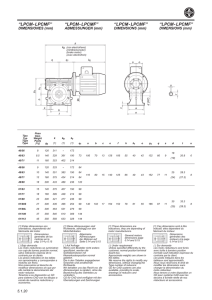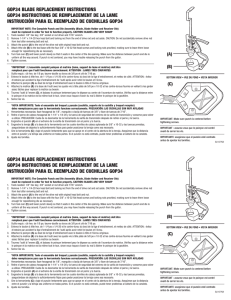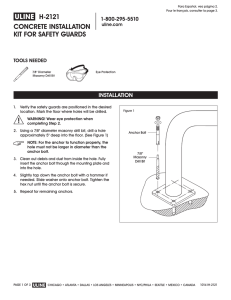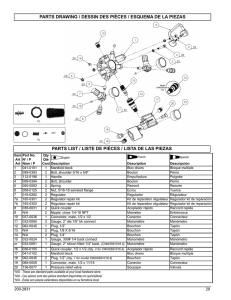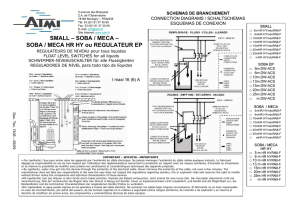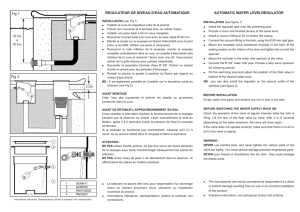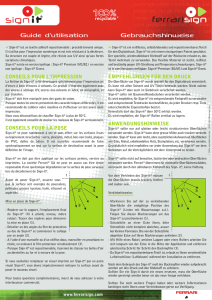ALFRA_Bedienungsanleitung_Blechlocher_v5 Kopie33
Anuncio
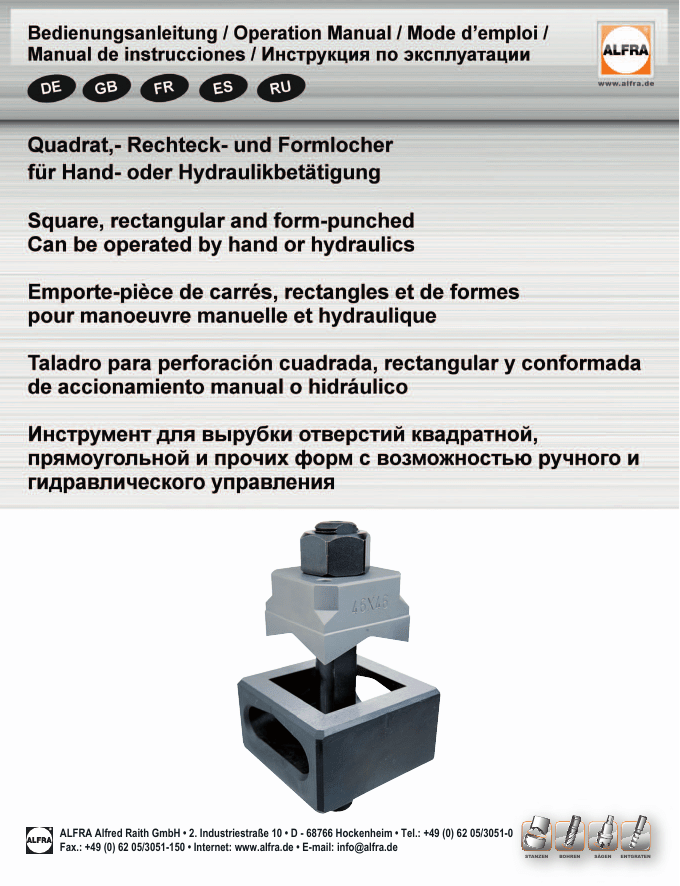
ALFRA Alfred Raith GmbH • 2. Industriestraße 10 • D - 68766 Hockenheim • Tel.: +49 (0) 62 05/3051-0 Fax.: +49 (0) 62 05/3051-150 • Internet: www.alfra.de • E-mail: [email protected] STANZEN BOHREN SÄGEN ENTGRATEN 10 2 6 8 9 7 1 4 3 1 2 3 4 5 5 Druckmutter Handbetätigung Zugbolzen Kontermutter Matrize Stempel 6 7 8 9 10 Adapter Brücke Distanzbuchse Vorgebohrtes oder gestanztes Loch Hydraulikstanze oder Zylinder Anwendungsbereich VORSICHT Das Werkzeug ist nur für die in der Betriebsanleitung beschriebene Anwendung bestimmt. Eine andere Verwendung kann zu Unfällen oder Zerstörung des Werkzeugs führen. DE HINWEIS • Zu Ihrer eigenen Sicherheit benutzen Sie nur Zubehör bzw. Zusatzgeräte, die in der Bedienungsanleitung oder vom Hersteller empfohlen werden. • Bitte treffen Sie immer geeignete Schutzmaßnahmen und beachten Sie die für Sie gültigen Unfallverhütungsvorschriften. • Das Werkzeug muss in Abhängigkeit der Einsatzhäufigkeit und Beanspruchung regelmäßig auf einwandfreie Funktion geprüft werden. Sollten entsprechende Prüfungen vor Ort nicht möglich sein, können diese vom Hersteller vorgenommen werden. VORSICHT Reparaturen dürfen nur von geschultem Fachpersonal durchgeführt werden, andernfalls können Unfälle für den Betreiber entstehen. Hydraulikbetätigung Vorbohren mit Spiralbohrer oder Mehrstufenbohrer. Bei Universal-Werkzeugen die Druckmutter (1) vom Zugbolzen (2) entfernen. Den Adapter (6) mit dem Innengewinde auf das lange Gewinde vom Zugbolzen aufdrehen. Den Zugbolzen mit dem Adapter in das Aufnahmegewinde der Stanze oder des Zylinder einschrauben. Geeignete Distanzbuchse (8) auf den Zugbolzen stecken und am Zylinder ansetzen. Der Einsatz einer Distanzbuchse ist unbedingt erforderlich. Die Matrize (4) unverkantet auf den Zugbolzen aufsetzen. Den Zugbolzen durch das vorgebohrte Loch des Werkstücks stecken. Den Stempel (5) von der Rückseite unverkantet auf den Zugbolzen aufsetzen. Die Kontermutter (3) oder Brücke (7) mit allen Gewindegängen auf den Zugbolzen zum Stempel hin aufschrauben. Die Brücke muss ganzflächig am Stempel anliegen. Das Werkzeug mit den 4 Markierungen auf der Matrize am Fadenkreuz auf dem Werkstück ausrichten. Ventilrad schließen. Pumpenkörper mit einer Hand festhalten und langsam pumpen. Nach wenigen Hüben ist der Stanzvorgang beendet. Den Stempel ganz durch das Blech durchziehen. Nach dem Stanzvorgang den Hydraulikzylinder entlasten und die Kontermutter/Brücke lösen und den Stempel sowie die Matrize vom Zugbolzen entfernen. Der Stanzabfall fällt seitlich ganz leicht aus der Matrize. Ventilrad öffnen. Die eingebaute Feder drückt den Kolben wieder in die Ausgangsstellung zurück. Rundstempel abschrauben bzw. Kontermutter lösen. Stanzabfall aus der Matrize entfernen. DE Handbetätigung Die Druckmutter (1) auf das lange Gewinde vom Zugbolzen (2) aufdrehen. Die Matrize (4) unverkantet auf den Zugbolzen aufsetzen. Den Zugbolzen (2) durch das vorgebohrte Loch am Werkstück stecken. Den Stempel (5) von der Rückseite unverkantet auf den Zugbolzen aufsetzen. Die Kontermutter (3) mit allen Gewindegängen auf den Zugbolzen (2) zum Stempel (5) hin aufschrauben. Das Werkzeug mit den 4 Markierungen auf der Matrize am Fadenkreuz auf dem Werkstück ausrichten. Mit dem Schraubenschlüssel die Druckmutter (1) langsam betätigen. Darauf achten, dass sich das Werkzeug nicht verdreht. Den Stempel ganz durch das Blech durchziehen. Nach dem Stanzvorgang die Kontermutter lösen und den Stempel sowie die Matrize vom Zugbolzen entfernen. Der Stanzabfall fällt seitlich ganz leicht aus der Matrize. VORSICHT Nur soweit stanzen bis das Werkstück durchgestanzt ist. Unbedingt vermeiden, dass der Stempel innen auf der Matrize aufsitzt. Versetztes Stanzen (Nibbeln) ist nicht möglich und würde das Werkzeug zerstören. HINWEIS Zugbolzen, Gewinde, Schneidkanten und Führungen sollten immer eingeölt oder gefettet werden Stempel, Matrizen und Muttern lassen sich leichter bewegen und der Verschleiß wird erheblich reduziert. Je nach Abstumpfungsgrad das Werkzeug rechtzeitig nachschärfen lassen. DE 10 2 6 8 9 7 1 4 3 1 2 3 4 5 5 Hand operation of the pressure nut Tension bolt Lock nut Die Stamp 6 7 8 9 10 Adapter Bridge Spacer nut Pre-drilled or punched hole Hydraulic punch or cylinder Fields of application CAUTION The tool is intended for use only as described in the operating instructions. Any other form of usage can lead to accidents or destruction of the tool. GB NOTICE • For your own safety, only use the accessories and attachments recommended in the operating instructions or by the manufacturer. • Please always carry out all the required precautionary measures and observe all applicable accident prevention regulations. • Subject to the frequency of use and type of service, the tool must be checked regularly to ensure flawless functioning. If appropriate inspections are not possible at the place of use, these may be conducted by the manufacturer. CAUTION Repairs must only be performed by qualified personnel in order to avoid operator accidents. Hydraulic operation Drill holes beforehand with a spiral or multiple-step drill bit. With universal tools, remove the presure nut (1) from the tension bolt (2). Screw the adapter (6) with the inner threads onto the long threads from the tension bolt. Screw the tension bolt with the adapter into the receptacle threads of the punch. Put the correct spacer nut (8) onto the tension bolt and then attach to the cylinder. It is absolutely necessary to use a spacer nut. Place the die (4) onto the tension bolt so that it is not wedged in. Put the tension bolt into the pre-drilled hole on the work piece. Place the stamp (5) on the tension bolt. The rear side of the punch should not be wedged. Screw the lock nut (3) or bridge (7) with all threads onto the tension bolt to the stamp. The bridge link must sit flush against the stamp. Align the tool (with the four marks on the die) with the work piece, using the cross-hairs. Close the valve wheel. Hold the pump body with one hand, and pump slowly. The punching process is completed after a few strokes. Pull the stamp completely through the sheet. After the punching process, release the hydraulic cylinder. Detach the lock nut/bridge and remove the stamp and the die from the tension bolt. Residue from the punching will fall easily from the die in a lateral direction. Open the valve wheel. The built-in spring presses the plunger back into the starting position. Screw off the round stamp and remove the lock nut. Remove punch residue from the die. GB Hand operation Screw the lock nut (1) off of the long threads of the tension bolt (2). Place the die (4) onto the tension bolt so that it is not wedged in. Put the tension bolt into the pre-drilled hole on the work piece. Place the stamp (5) on the tension bolt. The rear side of the punch should not be wedged. Screw the lock nut (3) or bridge (7) with all threads onto the tension bolt to the stamp. Align the tool (with the four marks on the die) with the work piece, using the cross-hairs. Use the spanner wrench to slowly move the pressure nut (1). Make sure that the tool itself does not twist. Pull the stamp completely through the sheet. After the punching process, detach the lock nut and remove the stamp and die from the tension bolt. Residue from the punching will fall easily from the die in a lateral direction. CAUTION Only continue with the punching process until the work piece is punched though. It is very important to avoid that the inside of the stamp rests on the die. Offset stamping (nibbling) is not possible, and will destroy the tool. Important! NOTICE Tension bolts, threads, cutting edges and guides should always be oiled or greased. The stamps, dies and nuts will then move more freely and friction will be significantly reduced. The tool should be sharpened regularly, at intervals which depend on how dulled the edges are. GB 10 2 6 8 9 7 1 4 3 1 2 3 4 5 5 Ecrou de pression pour manœuvre manuelle Goujon Contre-écrou Matrice Poinçon 6 7 8 9 10 Adaptateur Contre-écrou rectangulaire Douille d‘écartement Pré-perçage ou avant-trou perforé Presse à poinçonner ou vérin hydraulique Domaine d‘utilisation ATTENTION Cet outil n‘est destiné qu‘à l‘utilisation prévue et décrite dans le mode d‘emploi. Toute autre utilisation peut conduire à des accidents ou à la destruction de l‘outil. FR AVIS • Pour votre propre sécurité, n’utilisez que les accessoires et éléments auxiliaires recommandés par la notice d’utilisation ou par le fabricant. • Veillez à toujours prendre les mesures de protection adéquates et observer le règlement de prévention contre les accidents en vigueur dans votre cas. • Le bon fonctionnement de l’outil doit être contrôlé régulièrement, en fonction de la fréquence et du type d‘utilisation. En cas d’impossibilité de procéder à ces contrôles sur le site, s’adresser au fabricant. ATTENTION Afin d‘éviter tout risque d’accident pour l’exploitant, seul un personnel qualifié est habilité à effectuer les réparations. Manœuvre hydraulique Percer un avant-trou à l‘aide d‘un foret hélicoïdal ou étagé. Sur les outils universels, ôter l‘écrou de pression (1) du goujon (2). Visser l‘adaptateur (6) par le taraudage sur le filetage long du goujon. Visser le goujon avec l‘adaptateur dans le filetage de la presse à estamper ou du vérin. Enfiler la douille d‘écartement (8) qui convient sur le goujon et l‘appliquer sur le cylindre. L‘emploi d‘une douille d‘écartement est impératif. Enfiler sur le goujon la matrice (4) bien droite. Passer le goujon par l‘avant-trou de la pièce d‘œuvre. Appliquer le poinçon (5) par l‘arrière sur le boulon, bien droit. Visser le contre-écrou (3) ou le contre-écrou rectangulaire (7) avec tous les filets sur le goujon, vers le poinçon. Le contre-écrou rectangulaire doit reposer sur toute la surface le poinçon. Orienter l‘outil avec les 4 repères de la matrice sur le réticule de la pièce d‘œuvre. Fermer la manette de soupape. Tenir d‘une main le corps de pompe et pomper lentement. Après quelques coups, le cycle de poinçonnage est terminé. Passer complètement le poinçon à travers la tôle. Une fois le cycle de poinçonnage terminé, décharger le vérin hydraulique, enlever le contre-écrou et retirer du goujon le poinçon et la matrice. La débouchure sort très facilement sur le côté de la matrice. Ouvrir la manette de la soupape. Le ressort intégré repousse le piston dans sa position d‘origine. Dévisser le poinçon rond ou desserrer le contre-écrou. Ôter de la matrice la débouchure. FR Manœuvre manuelle Visser l‘écrou de pression (1) sur le long filetage du goujon (2). Enfiler sur le goujon la matrice (4) bien droite. Passer le goujon (2) par l‘avanttrou de la pièce d‘œuvre. Appliquer le poinçon (5) par l‘arrière sur le boulon, bien droit. Visser le contre-écrou (3) avec tous les filets sur le goujon, vers le poinçon. Orienter l‘outil avec les 4 repères de la matrice sur le réticule de la pièce d‘œuvre. A l‘aide d‘une clé plate, tourner lentement l‘écrou de pression (1). Veiller à ce que l‘outil ne se décale pas en rotation. Passer complètement le poinçon à travers la tôle. Une fois le cycle de poinçonnage terminé, desserrer le contre-écrou et retirer du goujon le poinçon et la matrice. La débouchure sort très facilement sur le côté de la matrice. ATTENTION Ne poinçonner que jusqu‘à ce que la pièce d‘œuvre soit perforée complètement. Eviter à tout prix que le poinçon ne repose en interne sur la matrice. Un poinçonnage décalé (grignotage) n‘est pas possible et détruirait l‘outil. AVIS Goujon, filetage, bords de coupe et guides doivent toujours être lubrifiés ou graissés. Le poinçon, les matrices et écrous sont ainsi plus mobiles et l‘usure est considérablement réduite. Selon le degré d‘usure, faire aiguiser l‘outil en temps utiles. FR 10 2 6 8 9 7 1 4 3 1 2 3 4 5 5 Tuerca de presión, accionamiento manual Perno de tracción Contratuerca Matriz Sello 6 7 8 9 10 Adaptador Puente Manguito distanciador Agujero perforado o punzonado Perforador hidráulico o cilindro Uso previsto PRECAUCIÓN Esta herramienta sólo está prevista para su uso conforme a estas instrucciones. Cualquier uso distinto al previsto puede causar accidentes o la destrucción de la herramienta. ES AVISO • Por su propia seguridad utilice únicamente los accesorios o aparatos adicionales recomendados en el manual de instrucciones o por el fabricante. • Le rogamos tome siempre las medidas de seguridad apropiadas y cumpla las prescripciones sobre prevención de accidentes que le sean aplicables. • Dependiendo de su frecuencia de uso y esfuerzo, es obligatorio comprobar periódicamente que la herramienta funcione perfectamente. Si no fuera posible la realización de las comprobaciones correspondientes in situ, éstas podrían ser efectuadas por el fabricante. PRECAUCIÓN Las reparaciones sólo pueden ser realizadas por personal técnico autorizado, en caso contrario el usuario correría riesgo de accidentes. Accionamiento hidráulico Taladro con punta espiral o taladro múltiple. En el caso de herramientas universales, retire la tuerca de presión (1) del perno de tracción (2). Enrosqe el adaptador (6) con el roscado interior sobre el roscado alargado del perno de tracción. Atornille el perno de tracción con el adaptador en el roscado de inserción de la cuchilla o del cilindro. Inserte el manguito distanciador 8) en el perno de tracción y en el cilindro. Es necesario utilizar siempre un manguito distanciador. Coloque la matriz (4) sin inclinarla en el perno de tracción. Inserte el perno de tracción a través del agujero perforado de la pieza de trabajo. Coloque el sello (5) de la parte trasera sin inclinarlo en el perno de tracción. Atornille la contratuerca (3) o el puente (7) con todas las roscas helicoidales en el perno de tracción en la dirección del sello. El puente debe quedar colocado con toda su superficie en contacto con el sello. Posicione la herramienta con las 4 marcas sobre la matriz en el retículo sobre la pieza de trabajo. Cierre la rueda de la válvula. Sostenga el cuerpo de la bomba con una mano y bombee poco a poco. Después de unas cuantas carreras finalizará el proceso de corte. Pasar el sello completamente a través de la chapa. Después del proceso de corte, descargue el cilindro hidráulico y suelte la contratuerca/puente y extraiga el sello y la matriz del perno de tracción. Los restos de corte caen a un lado fácilmente de la matriz. Abra la rueda de la válvula. El resorte integrado vuelve a presionar el émbolo hasta devolverlo a la posición inicial. ES Desatornille el sello redondo o suelte la contratuerca. Retire los residuos de corte que han quedado en la matriz. Accionamiento manual Enrosqe la tuerca de presión (1) en el roscado alargado del perno de tracción. Coloque la matriz (4) sin inclinarla en el perno de tracción. Inserte el perno de tracciónn(2) a través del agujero perforado de la pieza de trabajo. Coloque el sello (5) de la parte trasera sin inclinarlo en el perno de tracción. Atornille la contratuerca (3) con todas las roscas helicoidales en el perno de tracción en la dirección del sello (5). Posicione la herramienta con las 4 marcas sobre la matriz en el retículo sobre la pieza de trabajo. Accione lentamente la tuerca de presión (1) mediante la llave de ajuste. Procure que la herramienta no se desajuste. Pasar el sello completamente a través de la chapa. Después del proceso de corte, suelte la contratuerca y extraiga el sello y la matriz del perno de tracción. Los restos de corte caen a un lado fácilmente de la matriz. PRECAUCIÓN Corte sólo hasta que haya perforado la pieza. Evite siempre que el sello quede encastrado en el interior de la matriz. No es posible perforar (punzonar) con la máquina desequilibrada o desajustada, ya que ello destruiría la herramienta. AVISO Los pernos de tracción, roscados, bordes de corte y guías deben lubricarse con aceite y engrasarse periódicamente. Los sellos, matrices y tuercas podrán desplazarse mejor y ello reducirá notablemente su desgaste. Afile la herramienta siempre que ello sea necesario. ES 10 2 6 8 9 7 1 4 3 1 2 3 4 5 5 Зажимная гайка - ручное управление Стяжной болт Контргайка Матрица Пуансон 6 7 8 9 Переходник Перемычка Дистанционная втулка Предварительно просверленное или пробитое отверстие 10 Гидравлический штамп или цилиндр Область применения ОСТОРОЖНО Инструмент предназначен только для описанного в данной инструкции по эксплуатации применения. Любое другое использование может привести к несчастным случаям или разрушению инструмента. RU УКАЗАНИЕ • В целях собственной безопасности используйте только те принадлежности и дополнительные устройства, которые рекомендованы изготовителем в инструкции по эксплуатации. • Всегда принимайте соответствующие меры безопасности и соблюдайте действующие правила техники безопасности. • В зависимости от интенсивности использования и нагрузок необходимо регулярно проверять исправность работы инструмента. Если проведение соответствующих проверок невозможно на месте, они могут быть выполнены изготовителем. . ОСТОРОЖНО Проведение ремонта разрешается только обученным специалистам, в противном случае возможен риск несчастных случаев. Гидравлическое управление Предварительное сверление спиральным сверлом или многоступенчатым сверлом. На универсальных инструментах снимите зажимную гайку (1) со стяжного болта (2). Накрутите переходник (6) с внутренней резьбой на длинную резьбу стяжного болта. Вкрутите стяжной болт с переходником в приемную резьбу штампа или цилиндра. Установите подходящую дистанционную втулку (8) на стяжной болт и соедините с цилиндром. Использование дистанционной втулки строго обязательно. Установите матрицу (4) на стяжной болт, не допуская перекосов. Вставьте стяжной болт через предварительно просверленное отверстие заготовки. Установите пуансон (5) с задней стороны на стяжной болт, не допуская перекосов. Накрутите контргайку (3) или перемычку (7) всеми витками резьбы на стяжной болт по направлению к пуансону. Перемычка должна всей поверхностью прилегать к пуансону. Выверите инструмент с помощью 4 меток на матрице по перекрестию линий на заготовке. Закройте колесо вентиля. Удерживая корпус насоса, медленно качайте. Процесс вырубки будет завершен после выполнения нескольких ходов. Полностью протяните пуансон через листовой металл. После вырубки разгрузите гидравлический цилиндр и открутите контргайку/перемычку, после чего снимите пуансон и матрицу со стяжного болта. Отходы от вырубки свободно выпадут сбоку RU из матрицы. Откройте колесо вентиля. Встроенная пружина снова отожмет поршень обратно в исходное положение. Открутите круглый пуансон или отпустите контргайку. Удалите отходы от вырубки из матрицы. Ручное управление Накрутите зажимную гайку (1) на длинную резьбу стяжного болта (2). Установите матрицу (4) на стяжной болт, не допуская перекосов. Вставьте стяжной болт (2) через предварительно просверленное отверстие в заготовке. Установите пуансон (5) с задней стороны на стяжной болт, не допуская перекосов. Накрутите контргайку (3) всеми витками резьбы на стяжной болт (2) по направлению к пуансону (5). Выверите инструмент с помощью 4 меток на матрице по перекрестию линий на заготовке. С помощью гаечного ключа медленно поворачивайте зажимную гайку (1). Следите за тем, чтобы инструмент не проворачивался. Полностью протяните пуансон через листовой металл. После вырубки открутите контргайку и снимите пуансон и матрицу со стяжного болта. Отходы от вырубки свободно выпадут сбоку из матрицы. ОСТОРОЖНО Вырубку производите только до тех пор, пока не будет прорублена заготовка. Ни в коем случае не допускайте, чтобы пуансон находился изнутри на матрице. Смещенная относительно оси вырубка (вибрационная вырубка) невозможна и ведет к разрушению инструмента. УКАЗАНИЕ Стяжной болт, резьбы, режущие кромки и направляющие должны быть постоянно смазаны маслом или консистентной смазкой. Это обеспечивает более свободный ход пуансонов, матриц и гаек и значительно снижает износ. Инструмент нуждается в своевременной заточке по мере затупления. RU
